Oni Blog

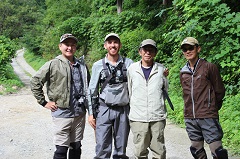
With Daniel of Tenkara USA and Ikutaro, who lives at the foot
of Mt. Hakusan where there used to be a lot of professional
tenkara fishers and some still fish for their livings.
Japan’s trout season is usually from March through September.
Each water is managed by fishermen’s union; thus the length of the
season can vary but is almost during this period.
Fishing for the season is targeted at salmonidae species such as amago,
yamame and iwana; they enter mating period from the end of September.
As the number of native fish (fish that are born and inhabit the water)
is declining in Japan, close season is important in order to increase
the number of fish.
Some fish in the highland over 600 meters elevation start the pairing
even from the beginning of September.
Tenkara fishers are usually sensitive to the nature, so they refrain from
fishing when they see the color of mating in the fish.
They wish for greater reproduction of fish, which they believe makes
them able to enjoy the sport.
This is what I always strongly hope.
I have to put out last spurt. I have decided where to go: where
I believe I could see big ones.
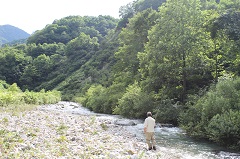
Quite a few iwana or char which can grow as long as 40cm can be caught
in this area. But on this day, fishing was tough. It takes 6 hours by car
to get here from most of the major cities.
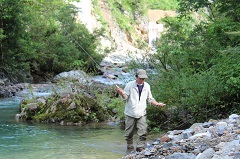
I gave a big #8 fly a first try to take a look at the river
condition and see how active the fish were.
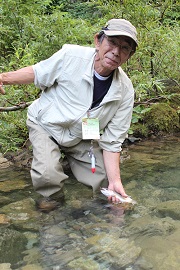
Fish are holding at the bottom of water; the fly should be sunk.
In tenkara, flies can be sunk without using weight or shots as we learn to sink them
by traditional knowledge of tenkara method.
It seems there has been some confusion on tenkara overseas.
What is Tenkara?
Only record left in writing on Japanese tenkara was “Tateyama
Climbing Journal” written by Earnest Satow, then secretary of the
British legation, who went together with the Minister Parks on his
journey. (cf. History page)
Japanese tenkara has been handed down from generation to
generation among professional fishermen in each local area.
And next tenkara record was written by Soseki Yamaoto in
showa era.
But they witnessed only some of the tenkara professionals.
They couldn’t see all of the professionals and matagi or
professional hunters.
All we have to do is just imagine other facts.
What we Japanese tenkara fishers have heard from old people
and stories of their forefathers in each locality is as important
as the recorded documents.
Tenkara started with ordinary materials found everywhere
in Japan: a bamboo for rod with a line attached to it.
The first line wasn’t only horse hair; also everyday items such as
silk threads, cotton threads and so forth were used together
with artificial flies on hooks.
Some may have put on many flies.
Tenkara as pleasure angling now taking root in our pastime,
has been evolving into several forms in conjunction with
western flyfishing that also now is taking hold in Japan.
For example, Mr. Horie uses flylines for tenkara.
Some use flyfishing flies for tenkara. I think the bottom
line is having fun!
It could be boiled down to “Every tenkara man (woman)
has his(her) style.”
I only deal with trout in the streams.
For lines, while I used many types, now I came to
conclusion that level lines or tapered lines with modern
design from horse hair lines.
I don’t use horse hair lines,because of heavy.
My obsession also goes to tippets.
I love supple but strong tippets.
For flies, I choose black, yellow and white. These are base
colors for me.
I only go as small as size #14 for hook size.
I do not use small flies like flyfishing.
This is because I always want to pay homage to the traditional
tenkara.
Also because I do not want to forget what my father and
other great senior masters taught to me.
Just like tenkara fishers from 1800’s,
I want to blend in with nature and enjoy tenkara.
What we have to do is not argue or discuss but go
fishing.
You could learn more in the field with your eyes
than in books even if you read tons of books.
What you learn in real terms will be your
invaluable pages for your own tenkara.
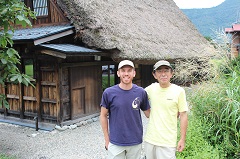
Got all the rooms to ourselves at the traditional thatched roof house.
We’ll hold Oni Juku class here next year!
COMMENTS
2 Responses to “Japanese streams and Tenkara”
Leave a Reply

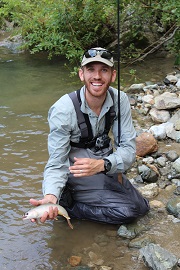
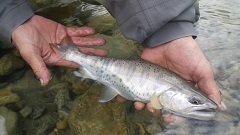
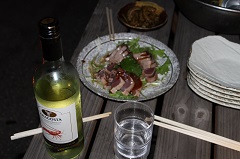
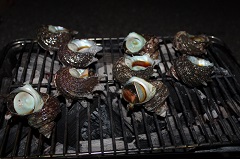
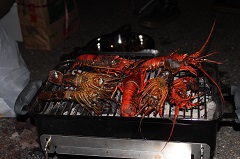
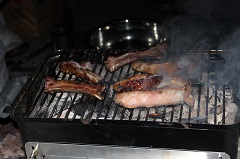
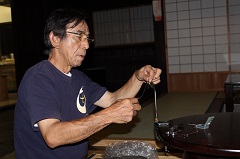
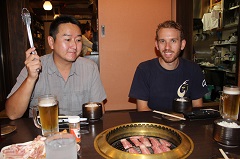
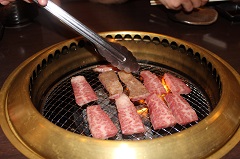
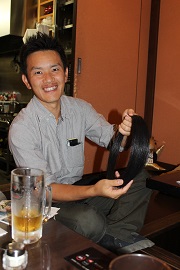




















September 11th, 2013 @ 11:23 PM
You can make a level horsehair line from just two hairs twisted together. It will be very light but you can cast it with your Oni rod. A level line made from three hairs will work with many tenkara rods and is still pretty light.
September 20th, 2013 @ 10:51 PM
Your words on this subject are refreshing. I appreciate that you take interest in other areas of the world to spread Tenkara. Thank you.